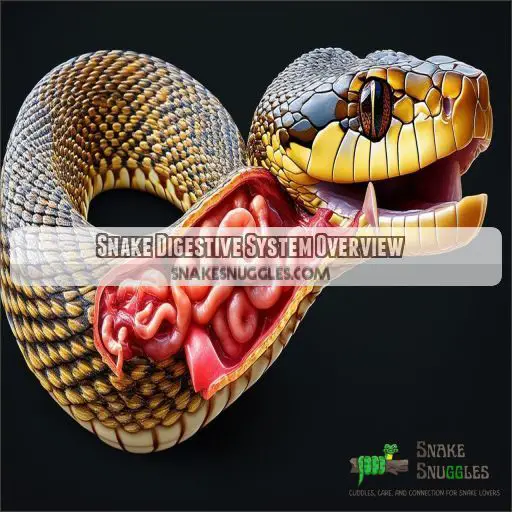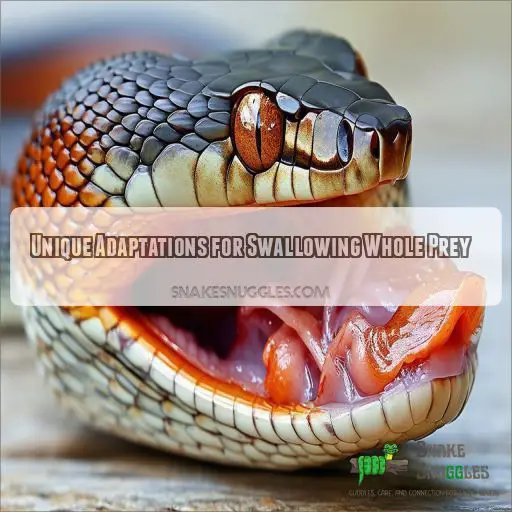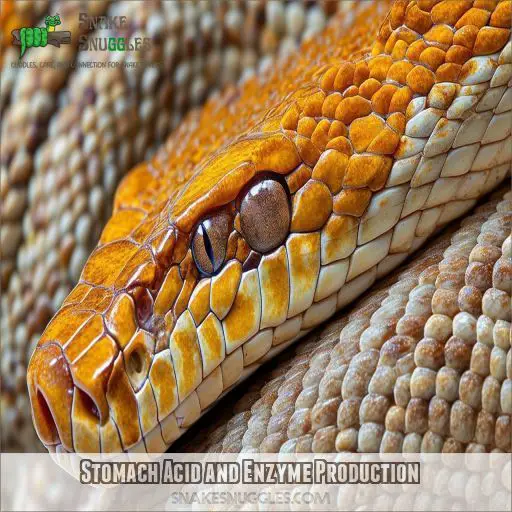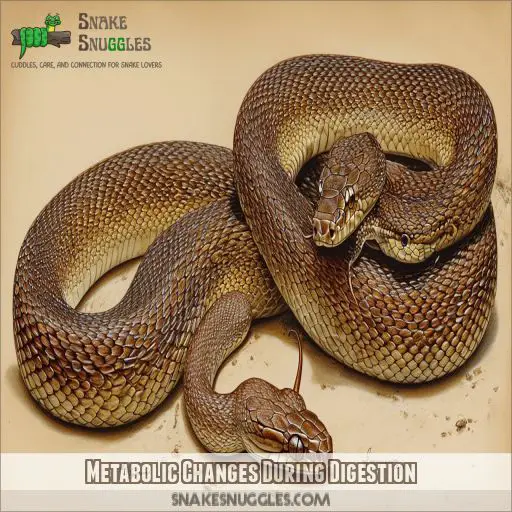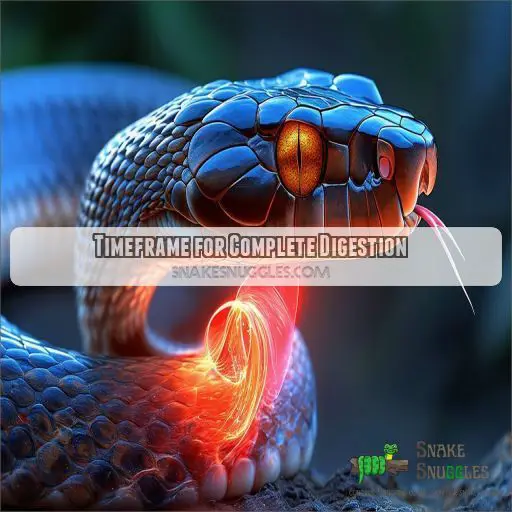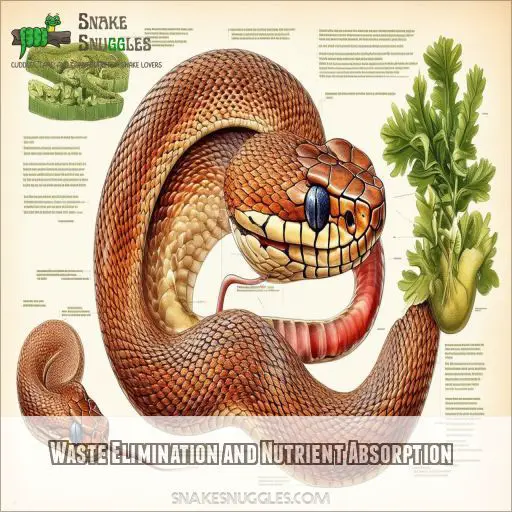This site is supported by our readers. We may earn a commission, at no cost to you, if you purchase through links.
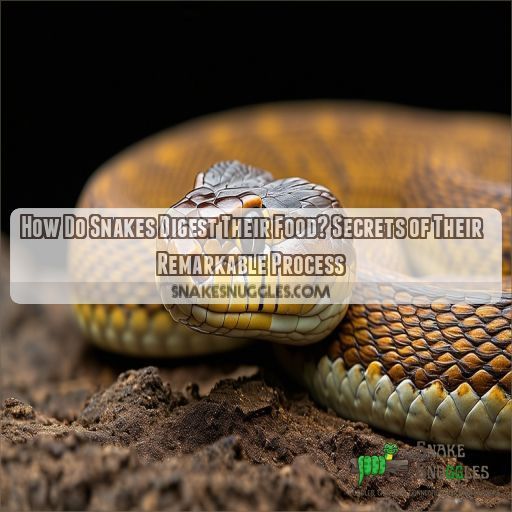
Their flexible jaws and skulls allow them to consume whole animals, while potent stomach acids and enzymes break down everything—bones, fur, and all. During digestion, a snake’s metabolism kicks into high gear, raising its heart rate and body temperature.
The entire process can take days or even weeks, depending on the prey’s size and the snake’s species. It’s a slow but thorough method that ensures maximum nutrient absorption.
Stick around to uncover more secrets of this incredible digestive feat!
Table Of Contents
- Key Takeaways
- How Do Snakes Digest Their Food?
- Snake Digestive System Overview
- Unique Adaptations for Swallowing Whole Prey
- Stomach Acid and Enzyme Production
- Metabolic Changes During Digestion
- Timeframe for Complete Digestion
- Waste Elimination and Nutrient Absorption
- Frequently Asked Questions (FAQs)
- How long does it take a snake to digest its food?
- How do snakes digest their food without chewing it first?
- How do snakes swallow their food whole?
- How do snakes digest large prey?
- How do snakes digest food?
- Do snakes swallow food?
- How long does it take a snake to digest a meal?
- How do snakes eat their prey?
- Can snakes digest bones and fur completely?
- How do snakes breathe while digesting large prey?
- What happens if a snake regurgitates its meal?
- Do snakes produce different feces than other animals?
- Does snake venom play a role in digestion?
- Conclusion
Key Takeaways
- Talk about a "gut-busting" meal! Snakes can swallow prey up to 1.6 times their size, thanks to their incredible jaw flexibility. It’s like they’re nature’s own contortionists, but for dining.
- These slithery gourmands don’t just eat – they go all in. Their potent stomach acids and enzymes break down everything, bones and fur included. It’s like having a built-in pressure cooker that never quits.
- Digestion is no quick snack for snakes. Depending on the size of their meal, it can take days or even weeks to fully process. Imagine spending that long digesting your breakfast!
- When it’s chow time, a snake’s body kicks into high gear. Their metabolism revs up, heart rate increases, and body temperature rises. It’s like their whole system is shouting, "Let’s get this digestive party started!
How Do Snakes Digest Their Food?
Snakes digest their food through a remarkable process that begins with swallowing prey whole using flexible jaws and powerful stomach acids. Their specialized digestive system breaks down entire animals efficiently, including bones and fur, while metabolic changes like increased heart rate and body temperature facilitate the digestion of large meals.
Snake Digestive System Overview
You might think a snake’s digestive system is simple, but it’s a marvel of evolution adapted for swallowing whole prey. Snakes have a highly specialized setup that allows them to process whole prey efficiently. Their digestive tract includes a mouth, esophagus, stomach, small intestine, and large intestine. What’s remarkable is how these organs work together to break down food completely.
The stomach is where the magic happens. It produces powerful gastric acids and digestive enzymes that can dissolve bones, fur, and even keratin. As food moves through the system, nutrients are absorbed in the small intestine. The large intestine then processes waste for elimination.
What sets snakes apart is their ability to dramatically ramp up their digestive processes when needed. They can increase enzyme production and boost their metabolism to handle large meals. It’s a fascinating process that allows these creatures to thrive on infrequent, sizeable feasts.
Unique Adaptations for Swallowing Whole Prey
Snakes have evolved remarkable adaptations that allow them to swallow prey much larger than their own heads. Their flexible jaws and skull, coupled with specialized teeth and saliva, enable them to manipulate and ingest whole animals efficiently.
Flexible Jaws and Skull
You’ve probably wondered how snakes manage to swallow prey much larger than their heads. It’s all thanks to their incredible jaw and skull flexibility. Unlike your rigid jaw, snakes have:
- Loosely connected jawbones
- Highly elastic ligaments
- Stretchy skin around the mouth
- A unique skull structure
This remarkable adaptation allows snakes to unhinge their jaws, expanding their mouths to an astonishing degree. It’s nature’s way of ensuring these slithering predators can tackle even the most challenging meals in their diet.
Specialized Teeth and Saliva
You’ll find that snakes’ teeth and saliva play important roles in their unique digestive process. Their sharp, backward-curving teeth aren’t for chewing but for gripping prey and guiding it down the throat.
Some snakes’ venom also immobilizes prey and aids in pre-digestion.
Their saliva, rich in lubricating compounds, helps form a slippery bolus, making swallowing whole animals a breeze for these remarkable carnivores.
Stomach Acid and Enzyme Production
Snakes produce incredibly powerful digestive juices that can break down entire prey animals, including bones and fur. These potent stomach acids and enzymes allow snakes to efficiently extract nutrients from their meals, dissolving even the toughest parts of their prey.
Powerful Digestive Juices
Regarding digestive efficiency, snakes excel. Their stomachs generate potent digestive fluids with a distinctive acid composition and enzyme variety that’s mind-boggling. These fluids are highly effective and can break down nearly everything a snake consumes whole. The key lies in their ability to swiftly increase production, ensuring that even substantial prey has no chance against their formidable digestive arsenal.
Breakdown of Bones and Fur
You’d be amazed at how snakes tackle bones and fur. Their potent digestive juices don’t just stop at soft tissues.
Enzymes break down keratin, the tough protein in fur, while strong acids dissolve bones. This remarkable ability allows snakes to extract maximum nutritional value from their prey, regardless of size.
It’s an evolutionary marvel that’s made them efficient ambush predators, digesting everything from tiny mice to large mammals.
Metabolic Changes During Digestion
When a snake consumes a meal, its metabolic rate dramatically increases to support the energy-intensive process of digestion. This boost in metabolism is accompanied by a significant rise in heart rate and body temperature, allowing the snake to efficiently break down and absorb nutrients from its prey.
Increased Heart Rate
As snakes begin to digest their meal, you’ll notice a remarkable change in their heart rate. These ambush hunters, known for their efficiency, experience a significant boost in circulation.
Their heart pumps faster, delivering oxygen-rich blood to aid in breaking down that recently swallowed prey.
This metabolic adaptation guarantees they can efficiently process everything from hair to scales, maximizing nutrient absorption from their infrequent meals.
Elevated Body Temperature
Along with increased heart rate, you’ll notice snakes elevate their body temperature during digestion. This metabolic boost aids in breaking down prey more effectively. Their respiration rate increases, fueling the digestive process.
Notably, some snakes utilize venom to initiate this process.
Be aware, though: if threatened, snakes may regurgitate their meal, resetting their metabolism.
Once digestion is complete, they’ll excrete waste and return to their cooler, slower state.
Timeframe for Complete Digestion
The time it takes for a snake to fully digest its meal depends on several factors, including prey size, environmental temperature, and the snake’s species. Unlike humans who typically digest meals in 24-72 hours, snakes can take days or even weeks to completely process their food, with larger meals requiring more time.
Factors Affecting Digestion Speed
Several factors influence a snake’s rate of digestion. The size of the prey, ambient temperature, and the snake’s metabolic rate all play important roles. Larger meals take longer to break down, while warmer temperatures accelerate the process.
As digestion progresses, you’ll notice metabolic changes, increased enzyme production, and heightened stomach acid levels. These adaptations work together to optimize nutrient absorption, ensuring the snake extracts maximum energy from its meal.
Comparison to Human Digestion
- Snakes’ lower body temperature slows metabolism
- Swallowing whole prey takes longer to break down
- Powerful digestive juices work overtime on fur and scales
Unlike you, snakes don’t move much after eating, focusing all energy on digestion.
Waste Elimination and Nutrient Absorption
You’ll find that snakes are incredibly efficient at extracting nutrients from their prey, absorbing almost all usable components through their digestive tract. The resulting waste, or excrement, is typically composed of indigestible materials like hair, claws, and teeth, along with uric acid, forming compact, dry pellets similar to bird droppings.
Efficient Nutrient Extraction
You’ll be amazed at how efficiently snakes extract nutrients from their prey. Their digestive system is a marvel of evolution, maximizing energy efficiency. The process involves a complex interplay of enzymes, bacteria, and specialized organs. Let’s break down this fascinating process:
| Aspect | Function | Key Players |
|---|---|---|
| Microbiome | Aids digestion | Beneficial bacteria |
| Enzymes | Break down proteins | Stomach acid |
| Small intestine | Absorbs nutrients | Villi and microvilli |
| Prey size | Affects efficiency | Larger prey = more nutrients |
| Nutrient partitioning | Allocates resources | Metabolic processes |
Composition of Snake Excrement
You’ll find snake excrement quite different from what you might expect. Their waste reflects their unique excretion strategy and efficient digestion. Here’s what you’ll typically see:
- Uric acid content: A white, chalky substance
- Hair and nails: Remnants of indigestible materials
- Compact, dry consistency: Due to efficient water absorption
- Infrequent elimination: Reflecting their slow metabolism
Waste analysis reveals snakes’ remarkable ability to extract nutrients, leaving behind only what they can’t use.
Frequently Asked Questions (FAQs)
How long does it take a snake to digest its food?
You’ll find that snake digestion varies widely. It can take anywhere from a few days to several weeks, depending on the snake’s size, the prey’s size, and environmental factors like temperature. Larger meals naturally take longer to digest.
How do snakes digest their food without chewing it first?
You’ll find snakes don’t need to chew. Their powerful digestive juices break down whole prey. They’ve evolved specialized stomachs that expand and produce extra acid. Their bodies also ramp up metabolism to efficiently process large meals.
How do snakes swallow their food whole?
Did you know snakes can swallow prey up to 6 times their body size? You’ll be amazed at how they do it. Their jaws aren’t fused, allowing them to open incredibly wide. They’ll use muscles to "walk" their mouth over prey.
How do snakes digest large prey?
Snakes digest large prey by boosting their metabolism and expanding their organs. You’ll witness their heart, stomach, and intestines grow markedly. They secrete potent enzymes that decompose everything, including bones, over several days or weeks.
How do snakes digest food?
Imagine a snake’s stomach as a powerful juicer! You’d swallow prey whole, then your specialized digestive system kicks into overdrive. Powerful acids and enzymes break down everything, even bones. You’d rest and digest for days or weeks.
Do snakes swallow food?
Yes, snakes swallow their prey whole. You’ll find they’ve flexible jaws that unhinge, allowing them to consume animals larger than their head. This unique adaptation lets them gulp down meals without chewing or breaking them apart.
How long does it take a snake to digest a meal?
Did you know snakes can take up to 14 days to digest a meal? Your snake’s digestion time depends on its size, the prey’s size, and temperature. Larger meals and cooler temperatures slow digestion, while warmer conditions speed it up.
How do snakes eat their prey?
You’ll be amazed at how snakes eat their prey! They unhinge their jaws, allowing them to swallow animals whole that are much larger than their heads. It’s a fascinating process that lets them consume sizeable meals.
Can snakes digest bones and fur completely?
Yes, snakes can fully digest bones and fur. Their powerful stomach acids break down these tough materials completely. You’ll find no trace of bones or fur in their waste. Even keratin, which makes up fur, is efficiently processed.
How do snakes breathe while digesting large prey?
You’ll find that snakes have a specialized trachea and lungs that aren’t easily compressed. This allows them to breathe even while digesting large prey. Their respiratory system’s adaptations guarantee they can maintain oxygen intake during the lengthy digestion process.
What happens if a snake regurgitates its meal?
Like a balloon popping mid-inflation, regurgitation deflates a snake’s meal plan. You’ll see the snake expel its prey, often partially digested. This stressful event can damage the snake’s esophagus and deplete its energy reserves.
Do snakes produce different feces than other animals?
Yes, snakes produce unique feces. You’ll notice their droppings resemble bird droppings, containing hair, nails, and uric acid. They’re often in identifiable boluses of resistant materials, reflecting the snake’s digestive efficiency and diet.
Does snake venom play a role in digestion?
Yes, snake venom can aid digestion. You’ll find that some vipers’ venom contains digestive enzymes, helping break down prey in cooler environments. This adaptation allows them to efficiently process their meals, even in less-than-ideal conditions.
Conclusion
Well, who knew snakes were such slow-motion gourmands? You’ve now uncovered the secrets of how snakes digest their food, from their jaw-dropping swallowing abilities to their potent digestive juices.
This remarkable process showcases nature’s efficiency, allowing snakes to extract maximum nutrients from their meals.
Next time you spot a snake with a bulging belly, you’ll know it’s not just lounging around—it’s hard at work, slowly but surely turning its prey into energy.
Snake digestion: a true proof of patience and biological ingenuity.

